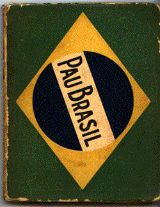The Pau-Brasil Movement is one of the modernist movements – Verde-Amarelismo or Escola da Tapir and Anthropophagic Movement – that took place in the First Phase of Modernism in Brazil, known as the “Heroic Phase”, a phase that presented different forms of patriotic approach .
This movement started in 1924 with the publication of the book “Pau-Brasil”, written by Oswald de Andrade (1890-1954) and illustration by his wife, the artist Tarsila do Amaral (1886 -1973).

abstract
Influenced by European avant-garde, the Modern Art Week was held in 1922 and with it various forms of innovative artistic expression emerged.
Following, Oswald de Andrade publishes the “Manifesto of Poetry Pau-Brasil”, which would come to be criticized by the group that came next, the Green-Yellow Movement, of 1926.
The Pau-Brasil Movement is a nativist movement that defended Brazilian export poetry. Just as brazilwood was the first Brazilian product to be exported, Oswald de Andrade wanted Brazilian poetry to become a cultural export product; hence the choice of the name of the movement.
Oswald de Andrade was known for his figure of irreverence and criticism of the academic and the bourgeoisie. Thus, he defended, at the same time as he criticized, nationalism in its own way, which came to be the target of judgment by the Green-Yellow Movement formed by Menotti del Picchia (1892-1988), Plínio Salgado (1895-1988), Guilherme de Almeida (1890-1969) and Cassiano Ricardo (1895-1974).
The patriotism defended by Verde-amarelismo contrasted that of Pau-Brasil, given that it is especially proud, as well as racist.
Next, Oswald de Andrade retaliates the movement of the Escola da Anta, giving rise to a new movement – the Anthropophagic Movement, in 1928, so that the first modernist movement can be considered the root of the latter, and a legacy for modern art .
Main features
The “Manifesto of Poetry Pau-Brasil” is one of the most important texts by Oswald de Andrade, a writer who, as we have seen, stood out in Brazilian modernist literature.
Primitivism is the main characteristic of this movement, in which patriotism embarked on paths of valorization of the Brazilian historical past devoid of the ufanist appeals of the Green-Yellow Movement.
“Poetry exists in the facts. The saffron and ocher hovels in the Favela greens, under the cabralino blue, are aesthetic facts.
….
The doctor side. Fatality of the first white man to arrive and politically dominating the wild jungles. The bachelor We cannot stop being learned. Doctors. Country of anonymous pain, of anonymous doctors. The Empire was like that. We erudiated everything.
(Excerpt from the “Pau-Brasil Poetry Manifesto”)
Thus, in addition to rescuing primitivism, the following are characteristics of the Pau-Brasil Movement:
- Critical review of the historical past
- Abandonment of academicism
- Enhancement of national identity
- Originality
- Colloquial and humorous language
